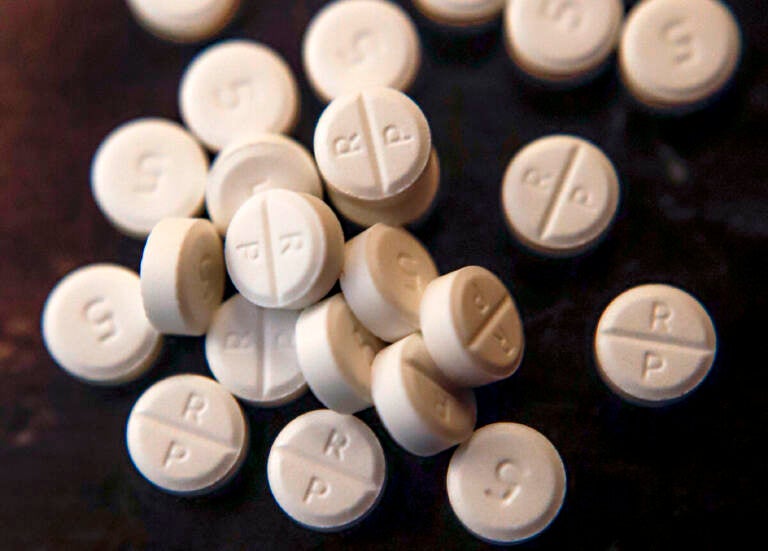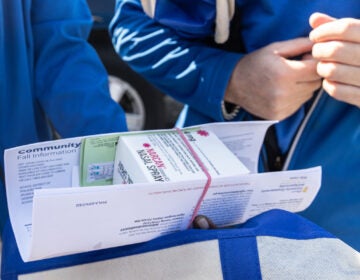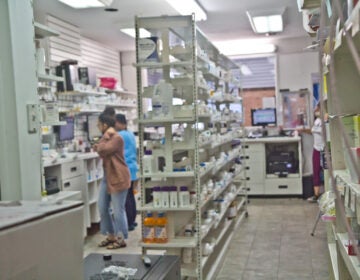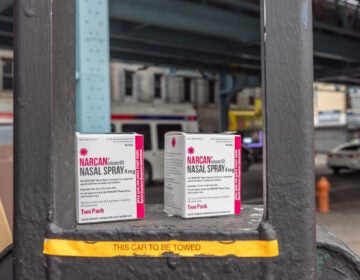Research finds some states are ignoring recommendations to improve opioid use disorder treatments
U.S. Food and Drug Administration–approved medications such as buprenorphine and methadone remain inaccessible for most people with opioid use disorder, Pew officials said.

This June 17, 2019, file photo shows 5-mg pills of Oxycodone. (AP Photo/Keith Srakocic, File)
From Philly and the Pa. suburbs to South Jersey and Delaware, what would you like WHYY News to cover? Let us know!
Throughout the country, most states are collecting data on how to effectively curb opioid overdose deaths. The problem — few are improving their treatment systems for people living with substance use disorder, according to a new report from Pew Charitable Trusts.
“What is missing in many states is a real concerted effort to bring together stakeholders to look at the data and make a plan … then look back and see, ‘Did we achieve the goals we set out to?’” said Frances McGaffey, associate manager of Substance Use Prevention and Treatment at Pew Charitable Trusts in Philadelphia.
This assessment comes from a self-reporting analysis used by Pew, which has been helping states improve care for people with opioid use disorder.
“Since 2017, Pew has provided technical assistance to states looking to improve their opioid use disorder treatment systems, and in that time, we’ve seen that states’ key decision makers aren’t accessing, or often implementing, needed reforms that could improve treatment and save lives,” McGaffey said.
In 2021, Pew formed an expert panel of officials throughout 49 states to determine the effectiveness of their opioid use disorder treatment systems. The goal was to create a set of metrics based on improving health equity, treatment system quality access to care and program creation.
“We had people who were state officials, federal officials, quality measurement experts, harm reductionists and treatment providers all get together and recommend a set of measures that states could be using to get a better handle on how well their treatment system is doing,” she said.
The panel decided on eight core measures, which included follow-up after an emergency department visit for substance use, initiation of substance use treatment and provider availability.
“The good thing about the measures that the expert panel selected is that most of them were already being used,” she said. “The federal government requires a lot of data reporting from states and that includes the measures that the Pew panel put together.”
In its assessment, while Pew found that most states were aggregating data to improve opioid treatment policies and programs, only a few reported steps taken to improve treatment systems. Some of those states included Alabama, Delaware, Indiana, Massachusetts, Pennsylvania, New Jersey and New York.
Researchers asked state officials about the most helpful way to improve upon their systems.
“The first is having strong leadership,” she said. “Making it clear from the executive branch that the approach to addressing the opioid crisis is going to be driven by data and really informed by acting on those data points.”
McGaffey also said that state officials cited having external partners with lived experiences guiding their process as helpful. But she also acknowledged that this could be challenging for some states.
“States need to dedicate resources to this. If you are going to be convening stakeholders, like treatment providers, people with lived expertise, county officials and other folks from across the state, that’s a lot of work. You need staff to do that,” she said.

Get daily updates from WHYY News!
WHYY is your source for fact-based, in-depth journalism and information. As a nonprofit organization, we rely on financial support from readers like you. Please give today.







